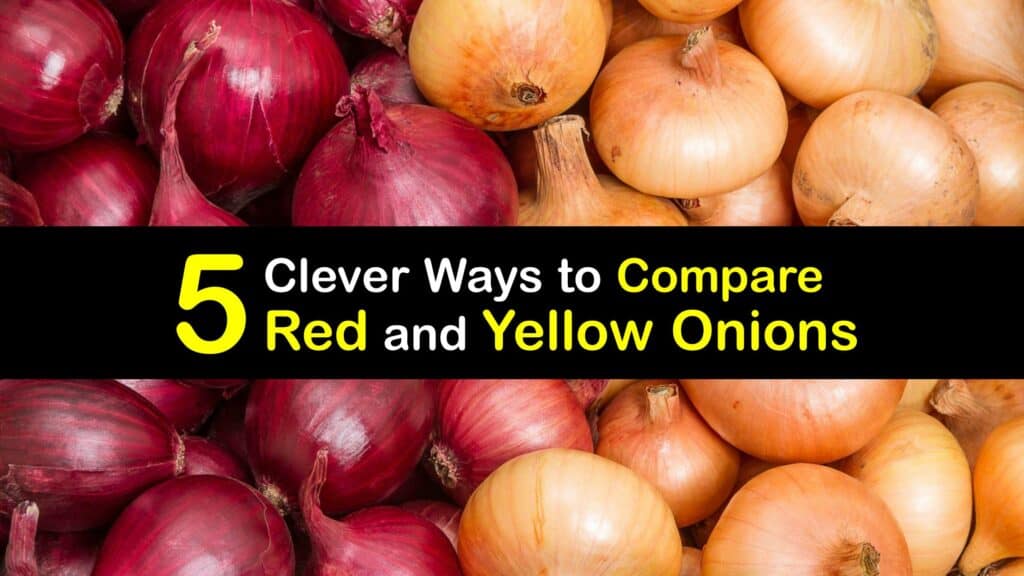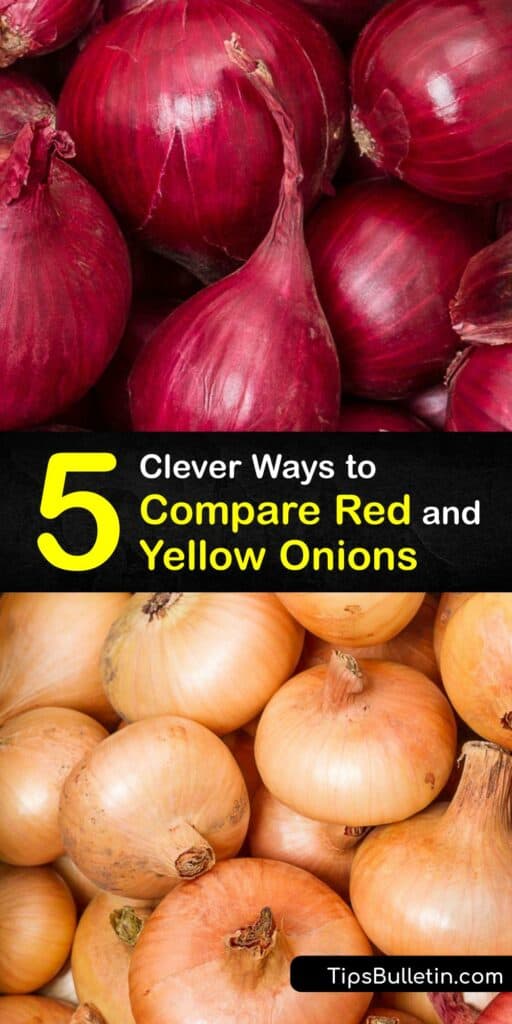When it comes down to what we know onions to be, round vegetables inside a papery skin, it may surprise you that the most common onions, red, yellow, and white, have many differences. When looking at red onion vs yellow onion, their taste is the most significant difference.
The Allium family is full of exciting and delicious plants like shallots, chives, leeks, and spring onions. Although it may seem that every species in this family tastes the same and are interchangeable, the plants in the Allium family are distinct in their flavor and texture.
This distinction means that not every vegetable related to the onion replaces the onion that your recipe calls for; even different types of onions may not substitute nicely. Before you replace white onions with green onions or scallions for pearl onions, continue reading to understand the difference between a yellow onion and a red onion.

What is the Difference between Red Onion and Yellow Onion?
In terms of their pungent flavor and strong smell, red onions are the strongest of the common onions, with a sharp oniony flavor. Yellow onions aren’t the same as sweet onions, and their flavor profile is between a white and red onion. This mild flavor makes yellow onions extremely popular in various recipes.
What is an Red Onion?
Red onions are cultivars of Allium cepa onions and grow medium to large bulbs. These onions are available all year after being dried and kept in storage. Similar to the white vs red onion, the onion flesh wrapped inside its paper skin is firm and crispy.

The color that red onions provide is part of the reason they’re included raw in many dishes; however, when cooked, they lose a lot of color. If you find the flavor of red onions too strong, soak your cut onions in water before cooking with them.
What is a Yellow Onion?
In the United States, yellow onions are the most common type of onion grown. Yellow onions are high in sulfur, giving them the strong flavor that makes yellow onions so popular. Commercial farms grow onions between the spring and fall growing seasons, drying and storing them for the remainder of the year. Uncut onions will last two to three months, making them a popular choice for the supermarket to carry.
The Visual Difference between Yellow and Red Onions
Known as purple onions in Europe, red onions develop round or oval-shaped bulbs with a purple-red outer skin that peels away to reveal a deep purple covering protecting the onion flesh. The onion flesh is white and red and has eye-watering qualities once cut.
Yellow or brown onions are bulb onions with a milder flavor than red onions. These onions have layers of yellow-brown papery skin with greenish-white flesh inside. Find yellow onions near Spanish onions that look similar in the grocery store with a sweeter flavor.
Nutritional Values of Red and Yellow Onions
Onions have a high water content with small amounts of protein and fat. Onions do not provide many essential nutrients, but we include them in meals for their texture and flavor profiles.
Looking closer at the nutritional difference between red onion and yellow onion, yellow onions are a good source of vitamin C and fiber. Red onions contain these values, but red onions contain fair amounts of iron and calcium.
Red onions have high quercetin content, giving them antioxidant properties that contribute to overall health. The sulfur in both of these onions promotes anti-inflammatory processes in the body.
Red Onion vs Yellow Onion in the Kitchen
Because neither red onions nor yellow onions are naturally sweet, it is possible to substitute red onion for yellow in a recipe and not tell the difference between red onion and yellow onion. Still, yellow onions often become the default if a recipe does not specify a type of onion.
What is an Red Onion Recipe?
Because of their intense flavor, red onions are commonly found raw in salads or diced into guacamole or tacos. Red onions are also grilled and included with other savory foods. When it comes to pickling, red onions are preferred. Their standout color makes red onions perfect for garnishing a plate.
Peel your onion, slice it thinly and add it to a jar or bowl. Juice four limes and add the juice to your onions and the rest of the ingredients. Cover and refrigerator your onions for at least 30 minutes before serving.
Using Yellow Onions in the Kitchen
As the most common cooking onion, yellow onions are utilized in various ways. We use yellow onions in stir-fry, French onion soup, and to make onion rings. They are also cooked in olive oil alongside meats and other vegetables to create side dishes.
Although they are eaten raw and included on sandwiches and even hot dogs, the mild onion flavor of white or yellow onions allows us to cook them on the stove until caramelized. Caramelizing onions breaks down the large sugar molecules inside the onion and brings their flavor out, making them sweeter than raw onions.
If you only use part of an onion in a recipe, store a cut onion in the fridge in an airtight container. It will keep for about a week.
What are Sweet Onions?
Separate from red and yellow onions, there is another type of bulb onion called the sweet onion. Despite the name, the sugar content is not much higher than red or yellow onions; however, sweet onions do not have a high sulfur content, so they are not pungent like red and yellow onions.
Like other onions, sweet onions are great when eaten raw or cooked and used in salads, sandwiches, and salsa. Because of their sweeter taste, sweet onions are the kind of onions used to create spreads and dips. Note that shallots are not the same as red onions, although sometimes the coloring is similar.
If you’ve ever questioned the difference between these onions and why some recipes call for specific onions, we hope that highlighting their flavor differences clarifies it. Although you can swap a yellow onion for red the next time you make guacamole, it’s essential to understand the main differences between these vegetables.

If our guide helped highlight the differences between red onion vs yellow onion, please share our article on these onions with your friends on Facebook and Pinterest to help answer questions like “What is an red onion exactly?”